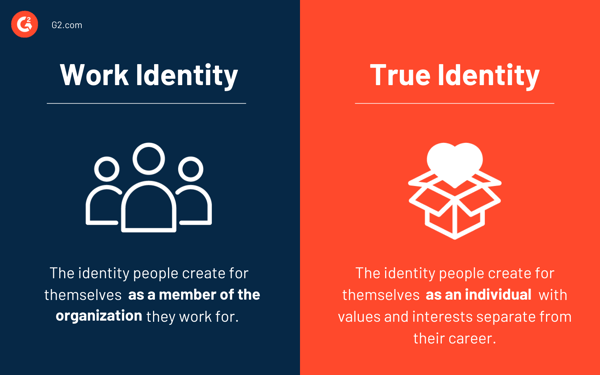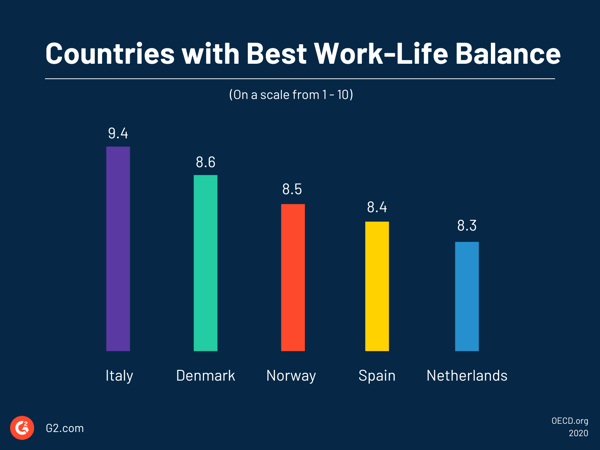March 17, 2023
 by Mary Clare Novak / March 17, 2023
by Mary Clare Novak / March 17, 2023

Personal or professional - setting healthy boundaries is essential.
Finding the perfect work-life balance between heavy workloads, career goals, relationships, and hobbies seems impossible. In an ideal world, our jobs will end with our working hours, leaving us enough time to focus on other things. However, the passion for succeeding professionally often pushes aside the boundaries needed for personal and mental well-being.
So, how do we define work-life balance when the line between work and life gets increasingly thinner? Spoiler alert: it's more complex than timings.
Work-life balance is a state of equilibrium every modern-day worker strives for. It’s achieved when an individual can equally prioritize the demands of their career and their personal life. It’s the satisfaction resulting from the time, energy, and attention they contribute to their work and life.
Employers are as responsible for creating and promoting work-life balance as employees. Many companies use employee engagement software to gain actionable insights through feedback and encourage activities that benefit employees' wellness.
A healthy work-life balance is associated with a sense of harmony. It positively affects your personal and professional relationships, mental and physical well-being, and happiness.
It’s no easy feat, but let this complete guide to work-life balance educate and inspire you to find harmony in your personal and professional life.
When employees achieve a work-life balance, the results can be seen in the form of higher productivity levels, lower absenteeism, improved motivation levels, and an overall healthier state of mind and body.
A positive work environment makes employees more likely to stay loyal and work harder. The stress levels are reduced, making them less likely to leave the organization. Higher employee engagement levels will ultimately benefit the company’s revenue and overall profitability. Companies that care for their employees’ well-being are recognized in the industry for their compassion. This, in turn, will attract talented applicants who want to be a part of the culture.
Along with benefits at the workplace, work-life balance also allows employees to improve their personal life and goals. You only get one life, so prioritize your relationships and personal goals as much as your professional ones.
Today’s workplaces revolve around one main idea: fast, efficient, low-cost solutions. Products and services that were once simple have become complex to stand out to consumers. These conditions have significantly impacted how individuals engage with their businesses and create work-related images for themselves.
Place of work has become an identifier. By working for an organization, individuals not only earn a paycheck but also associate who they are with their job title, their status as an employee, and the way their work stimulates them.
Since people gain a sense of identity from those they are surrounded by, employees consider themselves part of the corporate culture their employers represent. The organization's values, norms, and interests define how people work but can also be reflected in their actions outside of work. This results in employees corresponding their work identity with their true identity.

As employees interact with their coworkers, managers, and customers, it enforces their work identity. If someone’s work and true identities don’t align, it can create a poor work-life balance.
Unfortunately, the stressed importance of the physical safety and mental well-being of employees is a relatively new concern.
Towards the end of the Industrial Revolution, a 14-16 hour workday was the norm. People were overworked and often did so in dangerous conditions. As the health and safety of workers became more of a concern, in 1940, the U.S. enacted the Fair Labor Standards Act that enforced the 40-hour work week. As workers got used to having more time to themselves, the term “work-life balance” was coined in the 1980s.
It’s safe to say the modern-day workplace has changed significantly since then. New policies, like unlimited paid time off and the ability to work from home (WFH), have offered flexibility to employees. The incorporation of human resources and employee success departments has prioritized employee well-being. And the modern-day office is full of accommodations, such as free lunches, entertainment, and social spaces.
Overall, the modern-day workplace has made obtaining a work-life balance more feasible. However, there is still a disconnect. According to a survey conducted by GoodHire, only 46% of American workers feel that their managers genuinely respect personal time and time away from work. Needless to say, the opportunity is there, but reaching that balance will take some work.
As stated above, if your work identity and true identity don’t match up in terms of values, interests, and norms, an imbalance will occur. Since work-life balance includes only those two aspects of your life, an imbalance can happen when one demands more time and energy than the other.
If you are given more responsibilities at work, you might have to spend more time at the office or even bring your work home with you after you have already worked a full day.
After an event like a promotion, raise, or new project, people tend to focus on work and neglect their personal life. Even when they have the time to partake in personal activities (cooking dinner, gardening, cleaning their closet), they might feel unproductive because of the lack of recognition and monetary reward.
On the other side of the divide, some people have more demanding lives at home. Depending on their familial status, duties outside of work, and mental and physical health, people might have a hard time working a full eight-hour day with other commitments in their personal life.
Some people might think they don’t need a work-life balance. Perhaps they get all the satisfaction they need from their job. Or maybe they’re looking at their job solely as a method for paying the bills. If this is the case, the aspect they don’t care about likely needs more attention, evaluation, and adjusting.
If there is no harmony between your work and personal lives. Overcompensating for either aspect will cause an internal battle that’ll make you feel distressed and unable to sustain your personal or professional life.
Everyone will miss some work and events here and there, but those struggling with work-life imbalance will be excessively absent. If work or family requires more time and attention, compromises must be made. Even if they are physically present, mentally, people with work-life imbalance might be stressing out over how they wish they could be in two places at once.
The constant battle between spending more time at work or with family is not only grueling but also a huge time suck. While spending time at work and with loved ones is essential, people also need time to be completely alone. When struggling between work and personal life, finding time to be alone is challenging, which is when many people find it easiest to recharge.
When someone is fighting work-life imbalance, they know it, and it bothers them. This can have a significant effect on their mood and make them irritable. A comment from a family member about how they spend too much time at work can have a more substantial impact on that person than they think.
When people struggle with work-life imbalance, they cram as much work or family activities into as little time as possible. Unnaturally forcing all that energy can cause job burnout, having no desire to participate in anything.
Overall, the most significant adverse effect of work-life imbalance is stress, which can apply to everything mentioned above. Stress can cause absenteeism, tardiness, loss of personal time, irritability, and burnout.
There are many mental and physical health problems associated with too much stress. Physically, individuals struggling with anxiety can experience cardiovascular disease, a weakened immune system, and highly stiff muscles. Mentally, stressed people can encounter poor coping mechanisms, insecurity, and difficulty concentrating.
Unfortunately, only so much can be done about relieving these pains of work-life imbalance. Harmonizing work and life with an average 40-hour work week are difficult. Overworking to excel is the new norm, making it that much harder.
of US workers report that workplace stress affects their personal relationships.
Source: The American Institute of Stress
Based on the stat above, it can be concluded that citizens of the U.S. are overworked and stressed. But how does it compare to other developed countries?
The Organization for Economic Cooperation and Development (OECD) studied work-life balance based on time devoted to leisure/personal care and the number of employees working long hours. Here are the top five countries with the best work-life balance in the world:

All European countries. Every single one. That’s probably why discussions of work-life balance in the U.S. often include a comparison to the European Union.
The quality of work-life balance in any nation is altered by legislation, regulations, and, most importantly, workplace policies. The two biggest issues come down to parental leave and paid time off.
To conduct this U.S. vs. European Union comparison of work-life balance, let’s take a look at how the US squares up against Finland, which is number 16th on the list of countries with the best work-life balance, but more importantly, was just named the happiest country in the world by the 2022 World Happiness Report (in the same happiness report, the U.S. finished 16th).
Let’s start with parental leave. In Finland, maternity leave averages 21 weeks, or 105 weekdays. In addition, one of the parents can take an additional 158 weekdays off to look after their child—the total time off clocks at about 52 weeks, or one year.
While the U.S. claims to promote equal opportunity in the workplace, businesses fail miserably at family protection. The average time for parental leave in the U.S. is a measly 4.1 weeks or about 21 days.
In terms of paid time off, Finland, once again, overtakes the U.S. It’s federally required for employers in Finland to offer 36 total days of paid leave to their employees every year. Want to know how many days the U.S. government requires? Zero.
While many businesses grant their employees paid time off, the government does not require it. Compared to our European counterparts, the lifestyle and societal norms of the U.S. fail at stressing the importance of work-life balance and enabling employees to succeed.
No rules are set in stone for achieving the perfect work-life balance, but here are a few things to start on a good note:
Learn the art of saying no. Draw boundaries and manage expectations. Prioritize your work and gain control of your time. Say yes only when you know you can deliver.
Aim to be productive, not occupied. Work smart, not hard. Maintain to-do lists, schedule focus time, and downtime for mindfulness. Spend time on the right things at the right time.
Prioritize your mental and physical health. An unhealthy body or mind will never perform to its best capacity. Always put your health before work. Make time to exercise, eat right, get plenty of sleep, and stay hydrated.
Comparing the state of work-life balance in the U.S. to other, happier countries is discouraging. However, you have more control than you think. It might not be at the forefront of our society, but plenty can still be done to make this complicated task more feasible.
As an employer, you have a responsibility to your employees to create a corporate culture that encourages a balance between work and personal life. Not only will it make them happier, but it will also relieve the pains of work-life imbalance that can result in poor employee performance.
Here are some ways you can make it happen.
Flexibility in the workplace doesn’t mean you should allow employees to come and go as they like. It simply means allowing employees to alter the “nine to five” work day to fit their personal life.
Employees who like to take their child to school in the morning might arrive at 9:30 am and stay until 5:30 pm. Some people might like to have a few hours of daylight after work to spend time outside, and they might prefer a 7:30 am to 3:30 pm schedule. If they’re getting their work done, let them find a schedule that works for them.
Paid time off (PTO) policies group sick days, vacation days, and paid personal days into one category. This shows that you trust your employees to decide, as an adult, when they will decide to take time off work.
There’s no importance as to how the time off was spent. Again, as long as they finish their work, trust them to act responsibly.
This might sound like a counterpoint to work-life balance, but it actually supports it. The point of taking time off is to, well, take time off. If you allow unused PTO days to carry over to the next year, there’s a chance employees won’t take advantage of their allotted vacation time, which is bad for work-life balance.
Work-from-home policies are sweeping the nation. Probably because it benefits both employees and their employees.
Working from home offers the flexibility that employees crave. Cutting out commutes, creating your personal office space, and creating a schedule that works for you all deliver easy access to achieving work-life balance.
For the employer, it’s actually better for businesses to let their employees remotely. With the ability to work from home, people take less time off work and are more productive.
When someone takes a few days off work, they might still sit in on a phone call or answer an email or two. Make it known that when you say time off, you mean it. Don’t contact an employee if they’re out of the office. Everything will be waiting for them when they return.
Yes, your employees work for you. But above everything else, they’re humans with lives where both planned and unexpected events occur that might affect their coming to work. Be understanding and offer support where you can.
While employers can enable workers to find a good balance between work and personal life, the employees are still responsible for making it happen for themselves. You must take certain actions to find work-life balance as an employee - it won’t all be handed to you.
The first step in finding a work-life balance for yourself is accepting that perfection is impossible. When you hear the phrase work-life balance, you probably imagine yourself having a productive day at work and then going home to some good quality time with family.
Striving for perfection in your work-life balance is a lost cause. Be realistic, and know that some days you will focus more on work, and others you will focus more on your personal life. There’s no complete even split all the time. The balance happens over time, not all at once.
Finding a job you love is easier said than done, so let’s say that to achieve a work-life balance, you should search for a job you love. While work is something we do to make money, there should still be some semblance of passion and satisfaction from how you spend your professional time. You don’t need to be in love with it, but you shouldn’t dread going into the office every day.
Your mental and physical health should always be your first priority. If you are struggling with something in either of those areas, ensure you are taking the time to focus on it. If this is the case, be transparent about your situation with the leadership at your company.
Also, this might sound like a broken record, but try to set aside time to exercise. Whether you walk the dog, do yoga, or run, adding some movement to your day is a great method for feeling satisfied with your work-life balance because it involves activities that focus on you and you only.
Because our jobs can follow us everywhere now with modern technology, it’s important to realize when the time has come to unplug. Cutting ties with work when you’re not at the office is crucial to finding your desired work-life balance. If you don’t separate the two, getting there will be much harder.
A vacation might seem like an extreme measure for finding work-life balance, but sometimes, that’s what it takes! Completely shutting off work for a week, a couple of days, or just an afternoon can offer the refresh your brain and body need to find harmony. You might miss out on some work, but the benefits of taking a vacation outweigh the drawbacks.
Make sure you’re establishing boundaries for when it’s appropriate and inappropriate to do things associated with work. Leave your computer at the office, put your phone on do not disturb, or simply tell your colleagues you’re unavailable after a certain time.
This is especially important if you work from home. Because your personal and professional lives are happening in the same space, it can be hard to separate the two. If this is the case, set specific hours to start and end your work day to avoid burnout.
Your career is important, but it shouldn’t be your entire life. Getting caught up in work is easy, especially if you’re passionate about your job.
When pursuing work-life balance, ask yourself what it would look like for you, designate tasks to achieve it, and accept that although it will be a bumpy road, it’s well worth taking.
If you're new to working from home, check out G2’s WFH guide to learn how to stay on top of your game and remain productive when working remotely.
This article was originally published in 2020. It has been updated with new information.
Mary Clare Novak is a former Content Marketing Specialist at G2 based in Burlington, Vermont, where she is explored topics related to sales and customer relationship management. In her free time, you can find her doing a crossword puzzle, listening to cover bands, or eating fish tacos. (she/her/hers)
As an only child, family means the world to me.
 by Kristen McCabe
by Kristen McCabe
No one wants to work for an organization that is rigid or overly strict about policies.
 by Mara Calvello
by Mara Calvello
Pick a job you love, they said. You’ll never work a day in your life, they said.
 by Maddie Rehayem
by Maddie Rehayem
As an only child, family means the world to me.
 by Kristen McCabe
by Kristen McCabe
No one wants to work for an organization that is rigid or overly strict about policies.
 by Mara Calvello
by Mara Calvello


